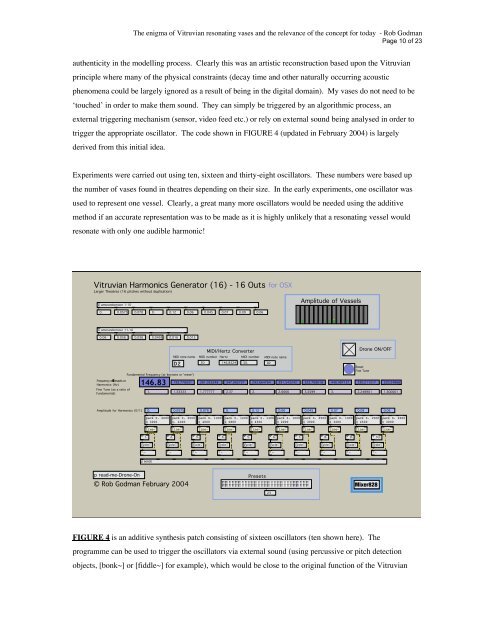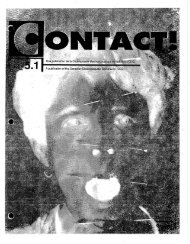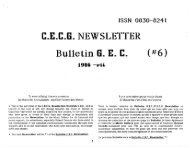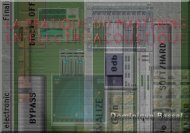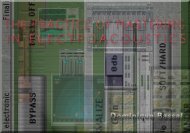The enigma of Vitruvian resonating vases and the relevance ... - CEC
The enigma of Vitruvian resonating vases and the relevance ... - CEC
The enigma of Vitruvian resonating vases and the relevance ... - CEC
Create successful ePaper yourself
Turn your PDF publications into a flip-book with our unique Google optimized e-Paper software.
<strong>The</strong> <strong>enigma</strong> <strong>of</strong> <strong>Vitruvian</strong> <strong>resonating</strong> <strong>vases</strong> <strong>and</strong> <strong>the</strong> <strong>relevance</strong> <strong>of</strong> <strong>the</strong> concept for today - Rob Godman<br />
Page 10 <strong>of</strong> 23<br />
au<strong>the</strong>nticity in <strong>the</strong> modelling process. Clearly this was an artistic reconstruction based upon <strong>the</strong> <strong>Vitruvian</strong><br />
principle where many <strong>of</strong> <strong>the</strong> physical constraints (decay time <strong>and</strong> o<strong>the</strong>r naturally occurring acoustic<br />
phenomena could be largely ignored as a result <strong>of</strong> being in <strong>the</strong> digital domain). My <strong>vases</strong> do not need to be<br />
‘touched’ in order to make <strong>the</strong>m sound. <strong>The</strong>y can simply be triggered by an algorithmic process, an<br />
external triggering mechanism (sensor, video feed etc.) or rely on external sound being analysed in order to<br />
trigger <strong>the</strong> appropriate oscillator. <strong>The</strong> code shown in FIGURE 4 (updated in February 2004) is largely<br />
derived from this initial idea.<br />
Experiments were carried out using ten, sixteen <strong>and</strong> thirty-eight oscillators. <strong>The</strong>se numbers were based up<br />
<strong>the</strong> number <strong>of</strong> <strong>vases</strong> found in <strong>the</strong>atres depending on <strong>the</strong>ir size. In <strong>the</strong> early experiments, one oscillator was<br />
used to represent one vessel. Clearly, a great many more oscillators would be needed using <strong>the</strong> additive<br />
method if an accurate representation was to be made as it is highly unlikely that a <strong>resonating</strong> vessel would<br />
resonate with only one audible harmonic!<br />
<strong>Vitruvian</strong> Harmonics Generator (16) - 16 Outs for OSX<br />
Larger <strong>The</strong>atres (16 pitches without duplication)<br />
p ampr<strong>and</strong>omizer 1-10<br />
0. 0.0575 0.078 0. 0.12 0.06 0.045 0.07 0.09 0.06<br />
p ampr<strong>and</strong>omizer 11-16<br />
0.06 0.056 0.036 0.0495 0.016 0.015<br />
Frequency <strong>of</strong> Vessels or<br />
Harmonics (Hz)<br />
Fine Tune (as a ratio <strong>of</strong><br />
Fundamental)<br />
Amplitude for Harmonics (0/1)<br />
p read-me-Drone-On<br />
Fundamental Frequency (or keynote or 'mese')<br />
146.83<br />
* 1.<br />
cycle~<br />
*~<br />
0.<br />
line~<br />
* 2.<br />
cycle~<br />
*~<br />
195.776031<br />
0.0575<br />
line~<br />
© Rob Godman February 2004<br />
* 3.<br />
cycle~<br />
*~<br />
0.078<br />
line~<br />
MIDI/Hertz Converter<br />
MIDI note name MIDI number Hertz MIDI number MIDI note name<br />
D2<br />
50 146.8324<br />
* 4.<br />
cycle~<br />
*~<br />
0.<br />
line~<br />
* 5.<br />
cycle~<br />
*~<br />
0.12<br />
line~<br />
Presets<br />
* 6.<br />
cycle~<br />
*~<br />
0.06<br />
line~<br />
* 7.<br />
cycle~<br />
*~<br />
Amplitude <strong>of</strong> Vessels<br />
0.045<br />
line~<br />
* 8.<br />
cycle~<br />
*~<br />
0.07<br />
line~<br />
* 9.<br />
cycle~<br />
*~<br />
Drone ON/OFF<br />
Reset<br />
Fine Tune<br />
261.035248 347.992737 293.664764 391.543243 522.708618 440.497131 330.211517 220.24866<br />
1. 1.33333 1.777777 2.37<br />
2. 2.6666<br />
3.5599 3.<br />
2.248901 1.500001<br />
pack 0. 2000 pack 0. 2000<br />
0 3000 0. 4000<br />
p sends<br />
pack 0. 1000 pack 0. 1200<br />
0 4000 0 2800<br />
50. D2<br />
pack 0. 1300 pack 0. 1000<br />
0 4300 0 2000<br />
23<br />
pack 0. 2500 pack 0. 1000<br />
0 3000 0 3200<br />
0.09<br />
line~<br />
* 10.<br />
cycle~<br />
*~<br />
0.06<br />
pack 0. 1500 pack 0. 2000<br />
0 4500 0 3000<br />
Mixer828<br />
FIGURE 4 is an additive syn<strong>the</strong>sis patch consisting <strong>of</strong> sixteen oscillators (ten shown here). <strong>The</strong><br />
programme can be used to trigger <strong>the</strong> oscillators via external sound (using percussive or pitch detection<br />
objects, [bonk~] or [fiddle~] for example), which would be close to <strong>the</strong> original function <strong>of</strong> <strong>the</strong> <strong>Vitruvian</strong><br />
line~<br />
* 11.<br />
cycle~<br />
*~<br />
165.920532 463.990021<br />
1.13 3.159998<br />
0. 0.3<br />
0.06<br />
line~<br />
* 12.<br />
cycle~<br />
*~<br />
0.056<br />
pack 0. 2000 pack 0. 2000<br />
0 3000 0. 4000<br />
line~<br />
* 13<br />
cycle<br />
*~


